Financial Analysis: Polymer Production Business Plan and KPIs
VerifiedAdded on 2023/06/15
|10
|2370
|233
Report
AI Summary
This report provides a comprehensive financial analysis for a polymer production business. It includes a summary of the business idea, focusing on polymer object production, an analysis of potential risks, and the initial funding sources. The report outlines key fixed and variable costs, a budgeted profit forecast for the first year, and a budgeted cash flow projection. It calculates the break-even point and margin of safety, identifies key performance indicators (KPIs) to monitor business goal progress, and provides recommendations based on the analysis. The analysis emphasizes the importance of raising sufficient revenue, maintaining professional connections, carefully selecting stakeholders, and managing costs effectively to ensure the business's sustainability and profitability while adhering to environmental regulations.
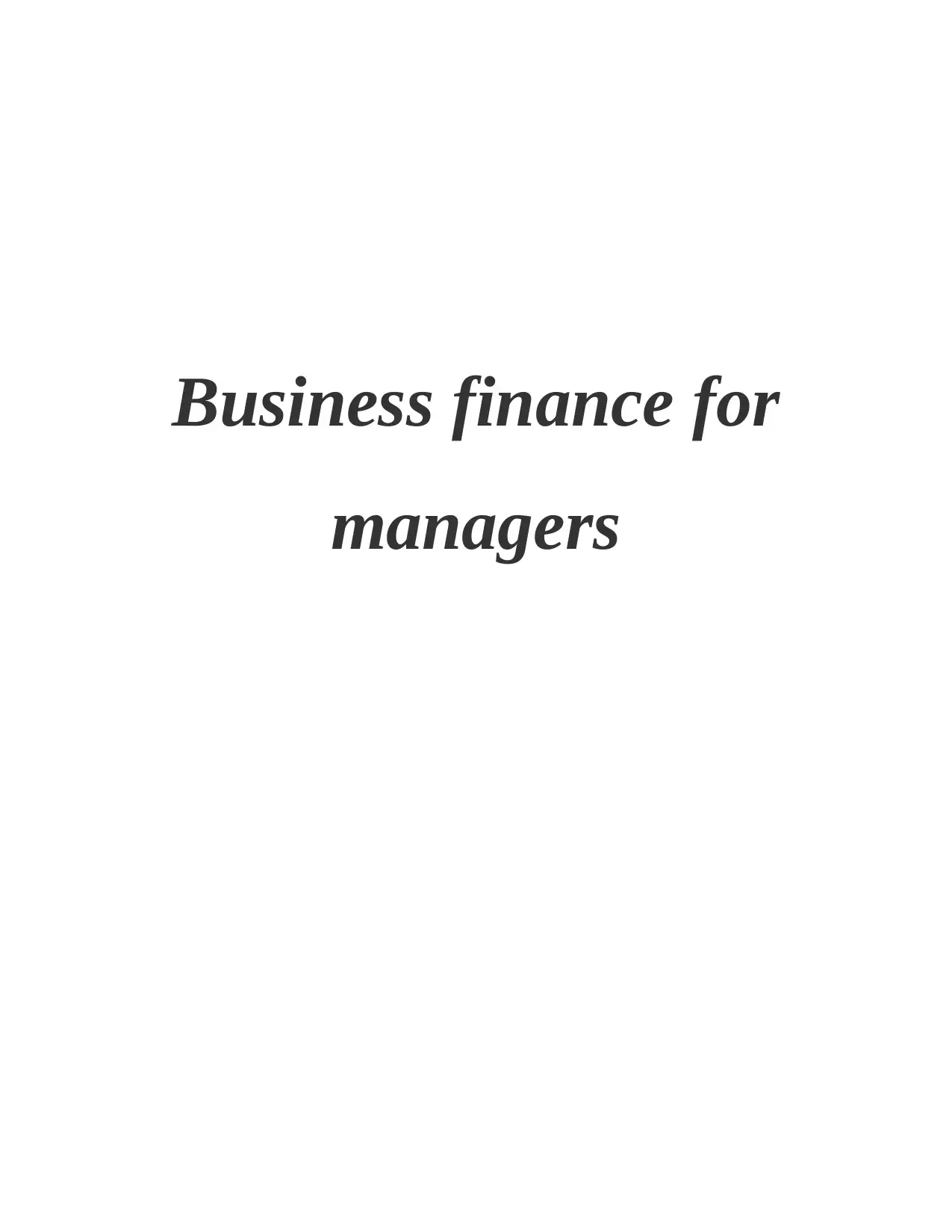
Business finance for
managers
managers
Paraphrase This Document
Need a fresh take? Get an instant paraphrase of this document with our AI Paraphraser
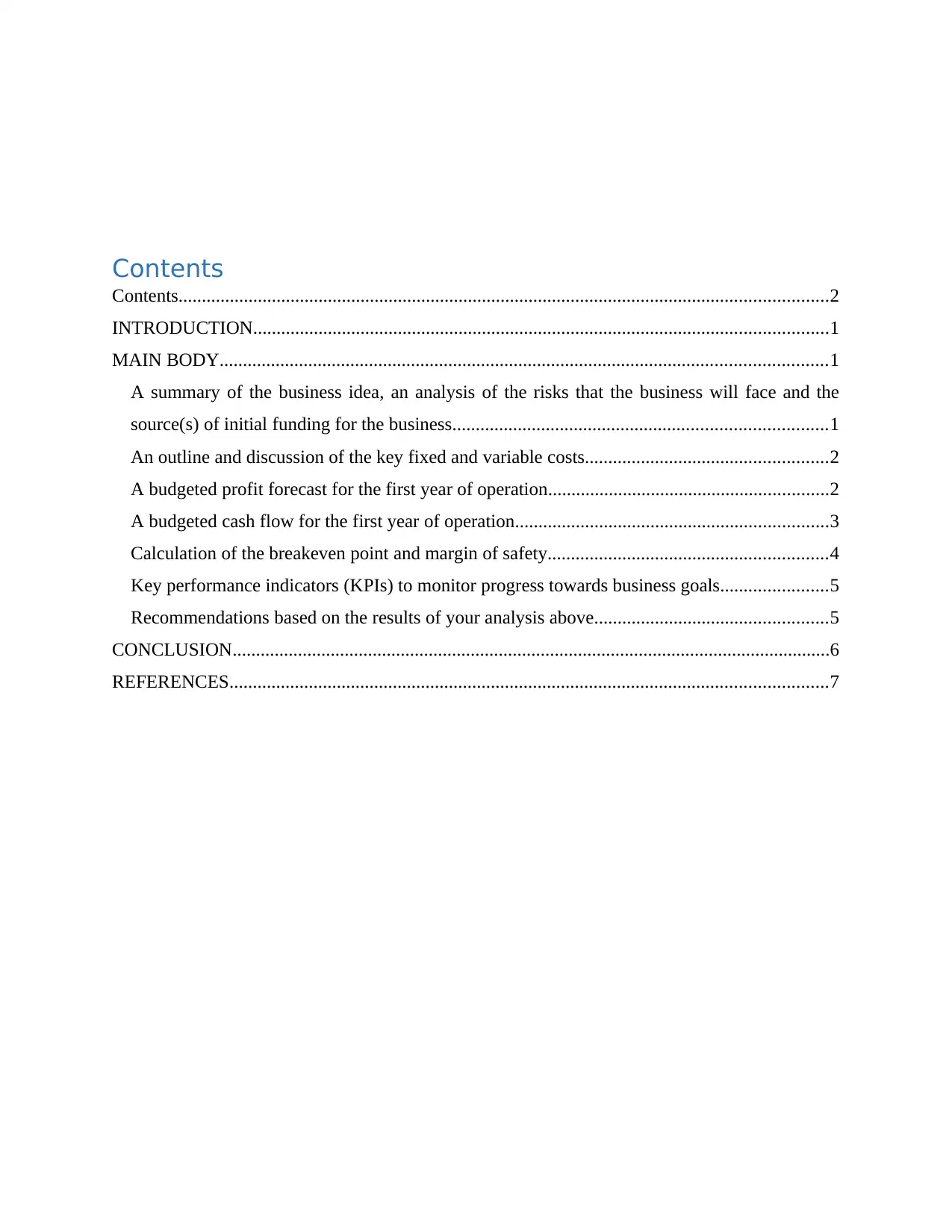
Contents
Contents...........................................................................................................................................2
INTRODUCTION...........................................................................................................................1
MAIN BODY..................................................................................................................................1
A summary of the business idea, an analysis of the risks that the business will face and the
source(s) of initial funding for the business................................................................................1
An outline and discussion of the key fixed and variable costs....................................................2
A budgeted profit forecast for the first year of operation............................................................2
A budgeted cash flow for the first year of operation...................................................................3
Calculation of the breakeven point and margin of safety............................................................4
Key performance indicators (KPIs) to monitor progress towards business goals.......................5
Recommendations based on the results of your analysis above..................................................5
CONCLUSION................................................................................................................................6
REFERENCES................................................................................................................................7
Contents...........................................................................................................................................2
INTRODUCTION...........................................................................................................................1
MAIN BODY..................................................................................................................................1
A summary of the business idea, an analysis of the risks that the business will face and the
source(s) of initial funding for the business................................................................................1
An outline and discussion of the key fixed and variable costs....................................................2
A budgeted profit forecast for the first year of operation............................................................2
A budgeted cash flow for the first year of operation...................................................................3
Calculation of the breakeven point and margin of safety............................................................4
Key performance indicators (KPIs) to monitor progress towards business goals.......................5
Recommendations based on the results of your analysis above..................................................5
CONCLUSION................................................................................................................................6
REFERENCES................................................................................................................................7

⊘ This is a preview!⊘
Do you want full access?
Subscribe today to unlock all pages.

Trusted by 1+ million students worldwide
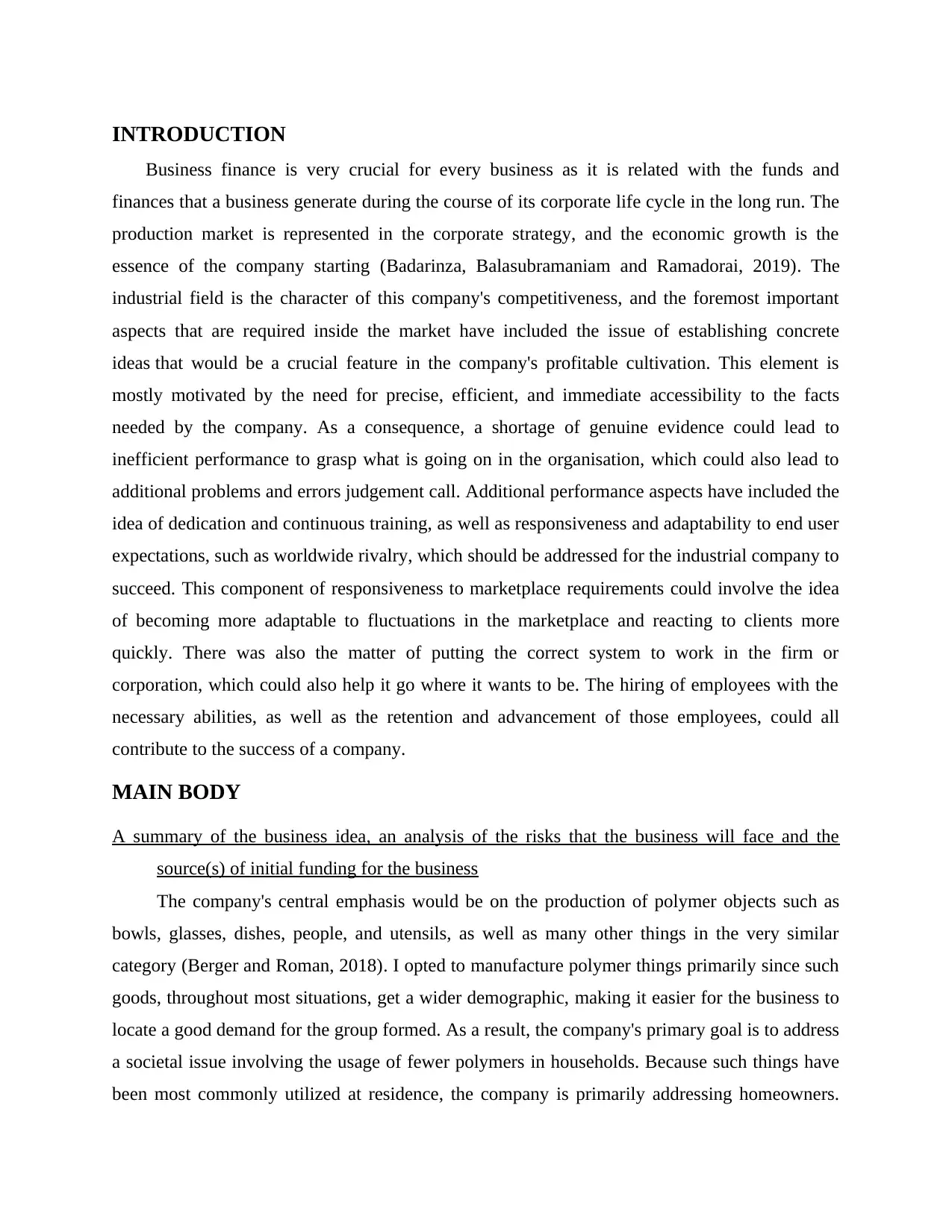
INTRODUCTION
Business finance is very crucial for every business as it is related with the funds and
finances that a business generate during the course of its corporate life cycle in the long run. The
production market is represented in the corporate strategy, and the economic growth is the
essence of the company starting (Badarinza, Balasubramaniam and Ramadorai, 2019). The
industrial field is the character of this company's competitiveness, and the foremost important
aspects that are required inside the market have included the issue of establishing concrete
ideas that would be a crucial feature in the company's profitable cultivation. This element is
mostly motivated by the need for precise, efficient, and immediate accessibility to the facts
needed by the company. As a consequence, a shortage of genuine evidence could lead to
inefficient performance to grasp what is going on in the organisation, which could also lead to
additional problems and errors judgement call. Additional performance aspects have included the
idea of dedication and continuous training, as well as responsiveness and adaptability to end user
expectations, such as worldwide rivalry, which should be addressed for the industrial company to
succeed. This component of responsiveness to marketplace requirements could involve the idea
of becoming more adaptable to fluctuations in the marketplace and reacting to clients more
quickly. There was also the matter of putting the correct system to work in the firm or
corporation, which could also help it go where it wants to be. The hiring of employees with the
necessary abilities, as well as the retention and advancement of those employees, could all
contribute to the success of a company.
MAIN BODY
A summary of the business idea, an analysis of the risks that the business will face and the
source(s) of initial funding for the business
The company's central emphasis would be on the production of polymer objects such as
bowls, glasses, dishes, people, and utensils, as well as many other things in the very similar
category (Berger and Roman, 2018). I opted to manufacture polymer things primarily since such
goods, throughout most situations, get a wider demographic, making it easier for the business to
locate a good demand for the group formed. As a result, the company's primary goal is to address
a societal issue involving the usage of fewer polymers in households. Because such things have
been most commonly utilized at residence, the company is primarily addressing homeowners.
Business finance is very crucial for every business as it is related with the funds and
finances that a business generate during the course of its corporate life cycle in the long run. The
production market is represented in the corporate strategy, and the economic growth is the
essence of the company starting (Badarinza, Balasubramaniam and Ramadorai, 2019). The
industrial field is the character of this company's competitiveness, and the foremost important
aspects that are required inside the market have included the issue of establishing concrete
ideas that would be a crucial feature in the company's profitable cultivation. This element is
mostly motivated by the need for precise, efficient, and immediate accessibility to the facts
needed by the company. As a consequence, a shortage of genuine evidence could lead to
inefficient performance to grasp what is going on in the organisation, which could also lead to
additional problems and errors judgement call. Additional performance aspects have included the
idea of dedication and continuous training, as well as responsiveness and adaptability to end user
expectations, such as worldwide rivalry, which should be addressed for the industrial company to
succeed. This component of responsiveness to marketplace requirements could involve the idea
of becoming more adaptable to fluctuations in the marketplace and reacting to clients more
quickly. There was also the matter of putting the correct system to work in the firm or
corporation, which could also help it go where it wants to be. The hiring of employees with the
necessary abilities, as well as the retention and advancement of those employees, could all
contribute to the success of a company.
MAIN BODY
A summary of the business idea, an analysis of the risks that the business will face and the
source(s) of initial funding for the business
The company's central emphasis would be on the production of polymer objects such as
bowls, glasses, dishes, people, and utensils, as well as many other things in the very similar
category (Berger and Roman, 2018). I opted to manufacture polymer things primarily since such
goods, throughout most situations, get a wider demographic, making it easier for the business to
locate a good demand for the group formed. As a result, the company's primary goal is to address
a societal issue involving the usage of fewer polymers in households. Because such things have
been most commonly utilized at residence, the company is primarily addressing homeowners.
Paraphrase This Document
Need a fresh take? Get an instant paraphrase of this document with our AI Paraphraser
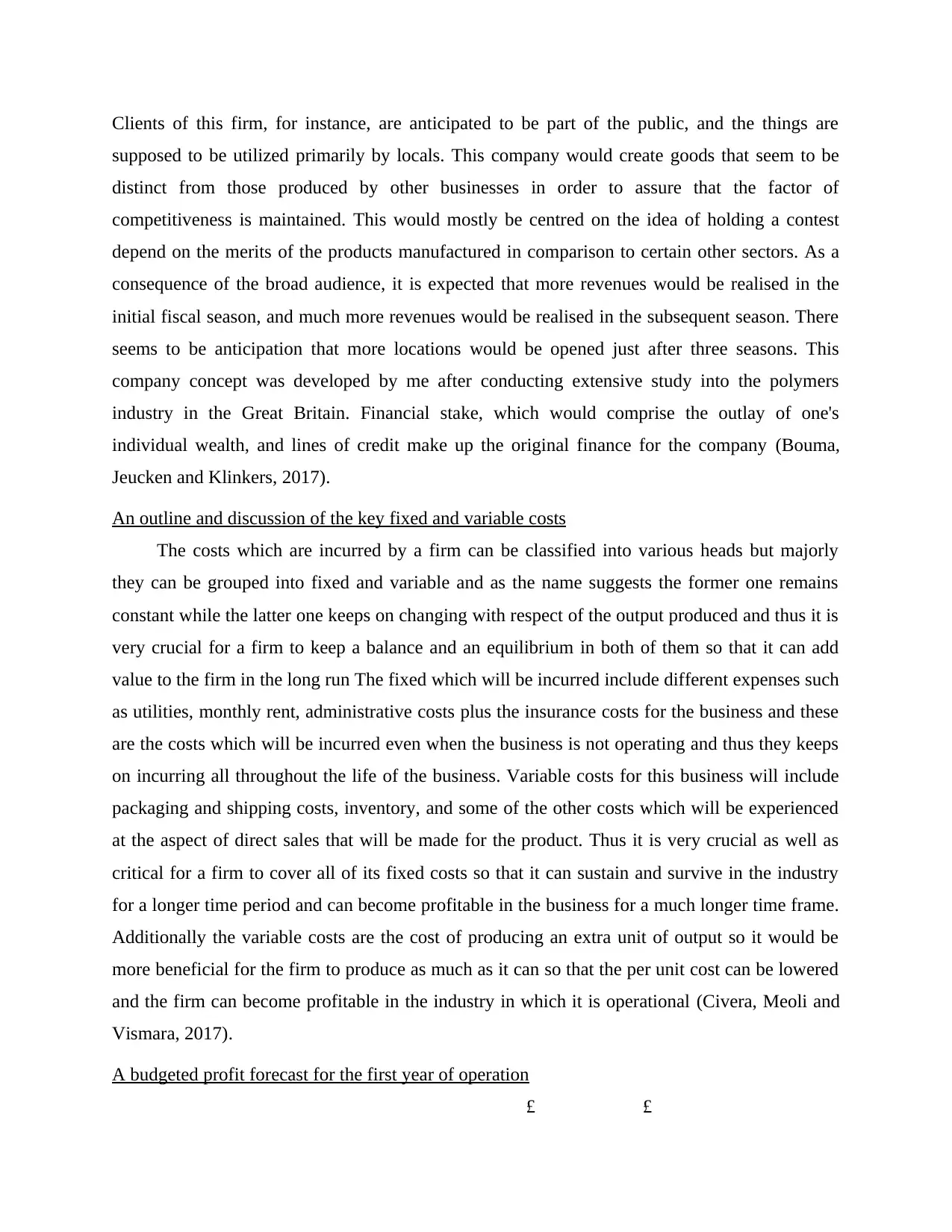
Clients of this firm, for instance, are anticipated to be part of the public, and the things are
supposed to be utilized primarily by locals. This company would create goods that seem to be
distinct from those produced by other businesses in order to assure that the factor of
competitiveness is maintained. This would mostly be centred on the idea of holding a contest
depend on the merits of the products manufactured in comparison to certain other sectors. As a
consequence of the broad audience, it is expected that more revenues would be realised in the
initial fiscal season, and much more revenues would be realised in the subsequent season. There
seems to be anticipation that more locations would be opened just after three seasons. This
company concept was developed by me after conducting extensive study into the polymers
industry in the Great Britain. Financial stake, which would comprise the outlay of one's
individual wealth, and lines of credit make up the original finance for the company (Bouma,
Jeucken and Klinkers, 2017).
An outline and discussion of the key fixed and variable costs
The costs which are incurred by a firm can be classified into various heads but majorly
they can be grouped into fixed and variable and as the name suggests the former one remains
constant while the latter one keeps on changing with respect of the output produced and thus it is
very crucial for a firm to keep a balance and an equilibrium in both of them so that it can add
value to the firm in the long run The fixed which will be incurred include different expenses such
as utilities, monthly rent, administrative costs plus the insurance costs for the business and these
are the costs which will be incurred even when the business is not operating and thus they keeps
on incurring all throughout the life of the business. Variable costs for this business will include
packaging and shipping costs, inventory, and some of the other costs which will be experienced
at the aspect of direct sales that will be made for the product. Thus it is very crucial as well as
critical for a firm to cover all of its fixed costs so that it can sustain and survive in the industry
for a longer time period and can become profitable in the business for a much longer time frame.
Additionally the variable costs are the cost of producing an extra unit of output so it would be
more beneficial for the firm to produce as much as it can so that the per unit cost can be lowered
and the firm can become profitable in the industry in which it is operational (Civera, Meoli and
Vismara, 2017).
A budgeted profit forecast for the first year of operation
£ £
supposed to be utilized primarily by locals. This company would create goods that seem to be
distinct from those produced by other businesses in order to assure that the factor of
competitiveness is maintained. This would mostly be centred on the idea of holding a contest
depend on the merits of the products manufactured in comparison to certain other sectors. As a
consequence of the broad audience, it is expected that more revenues would be realised in the
initial fiscal season, and much more revenues would be realised in the subsequent season. There
seems to be anticipation that more locations would be opened just after three seasons. This
company concept was developed by me after conducting extensive study into the polymers
industry in the Great Britain. Financial stake, which would comprise the outlay of one's
individual wealth, and lines of credit make up the original finance for the company (Bouma,
Jeucken and Klinkers, 2017).
An outline and discussion of the key fixed and variable costs
The costs which are incurred by a firm can be classified into various heads but majorly
they can be grouped into fixed and variable and as the name suggests the former one remains
constant while the latter one keeps on changing with respect of the output produced and thus it is
very crucial for a firm to keep a balance and an equilibrium in both of them so that it can add
value to the firm in the long run The fixed which will be incurred include different expenses such
as utilities, monthly rent, administrative costs plus the insurance costs for the business and these
are the costs which will be incurred even when the business is not operating and thus they keeps
on incurring all throughout the life of the business. Variable costs for this business will include
packaging and shipping costs, inventory, and some of the other costs which will be experienced
at the aspect of direct sales that will be made for the product. Thus it is very crucial as well as
critical for a firm to cover all of its fixed costs so that it can sustain and survive in the industry
for a longer time period and can become profitable in the business for a much longer time frame.
Additionally the variable costs are the cost of producing an extra unit of output so it would be
more beneficial for the firm to produce as much as it can so that the per unit cost can be lowered
and the firm can become profitable in the industry in which it is operational (Civera, Meoli and
Vismara, 2017).
A budgeted profit forecast for the first year of operation
£ £
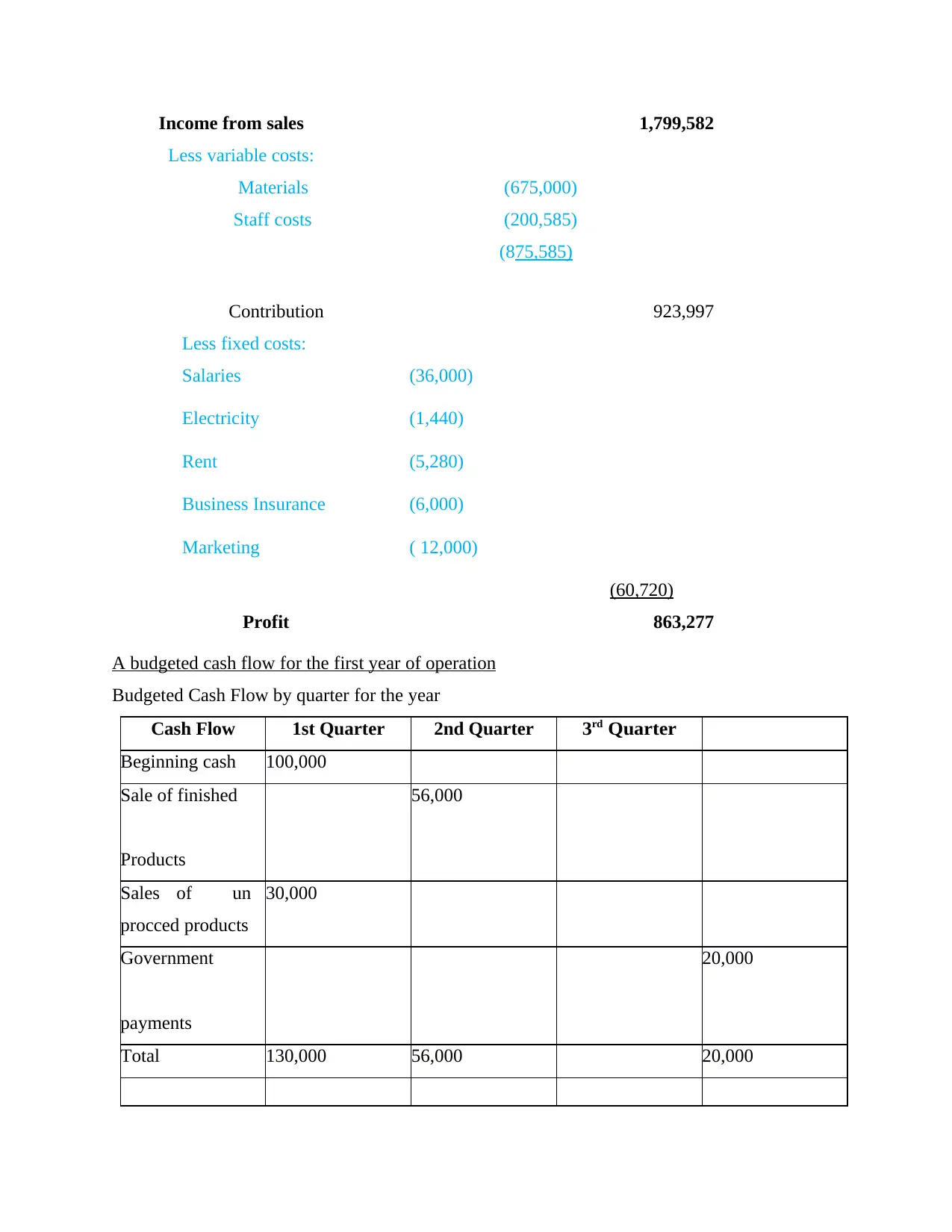
Income from sales 1,799,582
Less variable costs:
Materials (675,000)
Staff costs (200,585)
(875,585)
Contribution 923,997
Less fixed costs:
Salaries (36,000)
Electricity (1,440)
Rent (5,280)
Business Insurance (6,000)
Marketing ( 12,000)
(60,720)
Profit 863,277
A budgeted cash flow for the first year of operation
Budgeted Cash Flow by quarter for the year
Cash Flow 1st Quarter 2nd Quarter 3rd Quarter
Beginning cash 100,000
Sale of finished
Products
56,000
Sales of un
procced products
30,000
Government
payments
20,000
Total 130,000 56,000 20,000
Less variable costs:
Materials (675,000)
Staff costs (200,585)
(875,585)
Contribution 923,997
Less fixed costs:
Salaries (36,000)
Electricity (1,440)
Rent (5,280)
Business Insurance (6,000)
Marketing ( 12,000)
(60,720)
Profit 863,277
A budgeted cash flow for the first year of operation
Budgeted Cash Flow by quarter for the year
Cash Flow 1st Quarter 2nd Quarter 3rd Quarter
Beginning cash 100,000
Sale of finished
Products
56,000
Sales of un
procced products
30,000
Government
payments
20,000
Total 130,000 56,000 20,000
⊘ This is a preview!⊘
Do you want full access?
Subscribe today to unlock all pages.

Trusted by 1+ million students worldwide
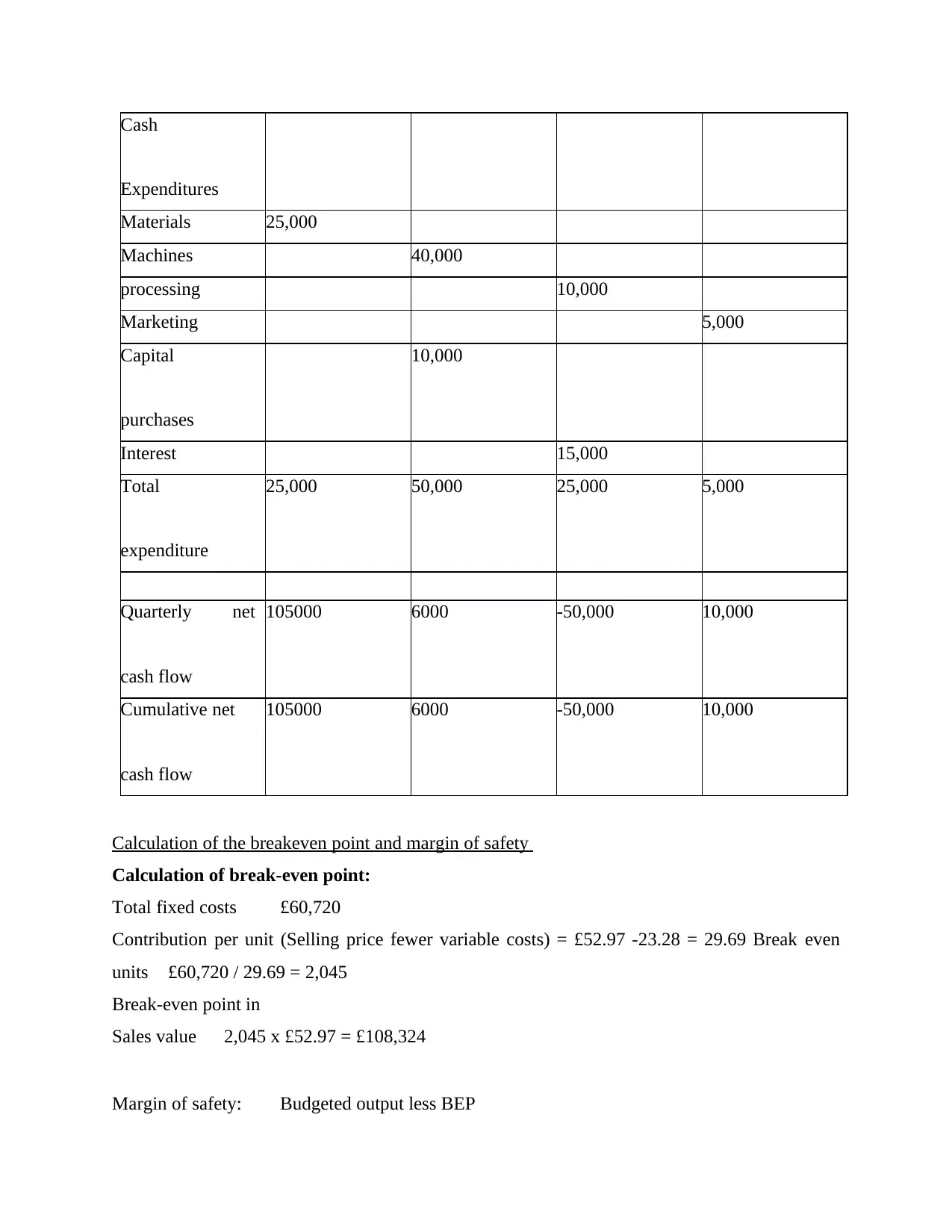
Cash
Expenditures
Materials 25,000
Machines 40,000
processing 10,000
Marketing 5,000
Capital
purchases
10,000
Interest 15,000
Total
expenditure
25,000 50,000 25,000 5,000
Quarterly net
cash flow
105000 6000 -50,000 10,000
Cumulative net
cash flow
105000 6000 -50,000 10,000
Calculation of the breakeven point and margin of safety
Calculation of break-even point:
Total fixed costs £60,720
Contribution per unit (Selling price fewer variable costs) = £52.97 -23.28 = 29.69 Break even
units £60,720 / 29.69 = 2,045
Break-even point in
Sales value 2,045 x £52.97 = £108,324
Margin of safety: Budgeted output less BEP
Expenditures
Materials 25,000
Machines 40,000
processing 10,000
Marketing 5,000
Capital
purchases
10,000
Interest 15,000
Total
expenditure
25,000 50,000 25,000 5,000
Quarterly net
cash flow
105000 6000 -50,000 10,000
Cumulative net
cash flow
105000 6000 -50,000 10,000
Calculation of the breakeven point and margin of safety
Calculation of break-even point:
Total fixed costs £60,720
Contribution per unit (Selling price fewer variable costs) = £52.97 -23.28 = 29.69 Break even
units £60,720 / 29.69 = 2,045
Break-even point in
Sales value 2,045 x £52.97 = £108,324
Margin of safety: Budgeted output less BEP
Paraphrase This Document
Need a fresh take? Get an instant paraphrase of this document with our AI Paraphraser
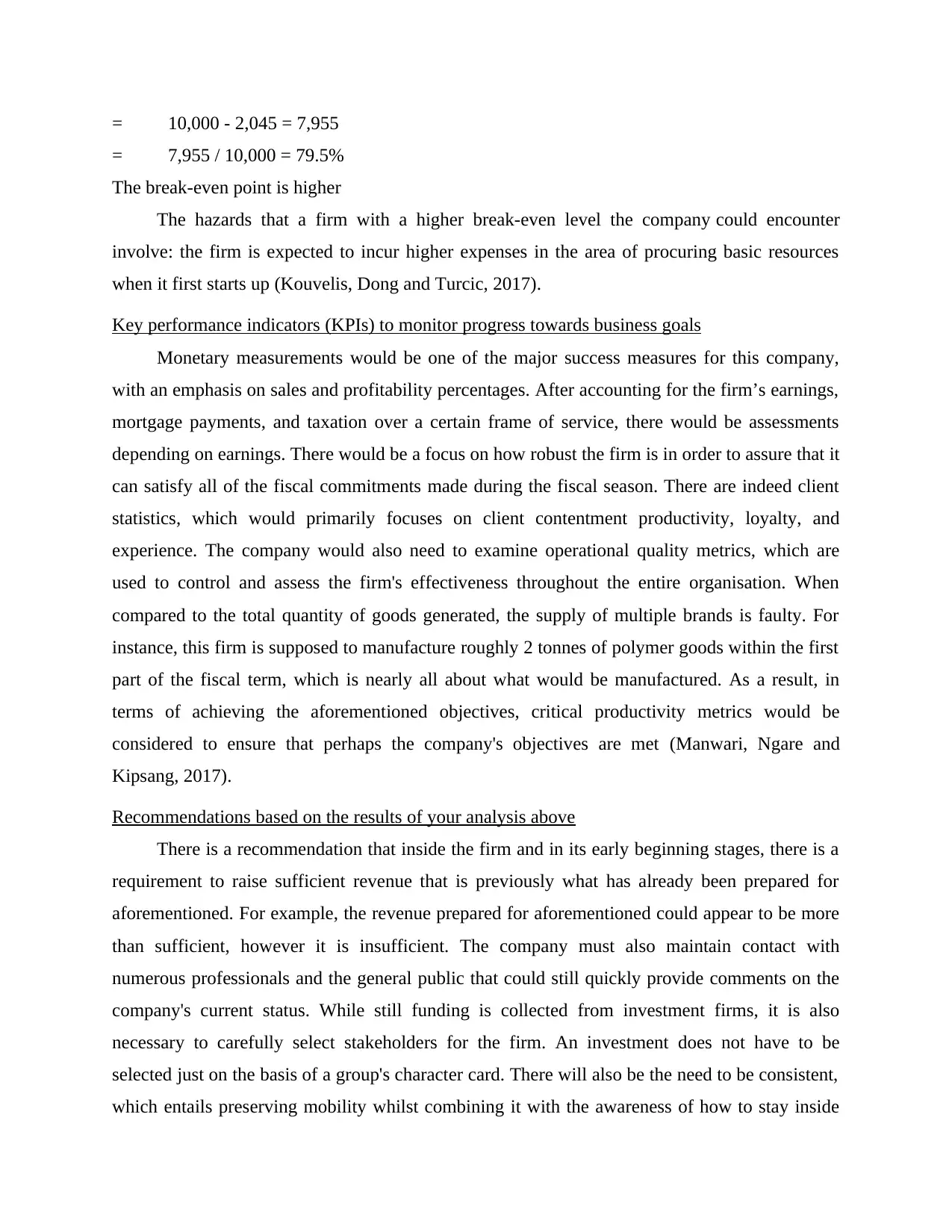
= 10,000 - 2,045 = 7,955
= 7,955 / 10,000 = 79.5%
The break-even point is higher
The hazards that a firm with a higher break-even level the company could encounter
involve: the firm is expected to incur higher expenses in the area of procuring basic resources
when it first starts up (Kouvelis, Dong and Turcic, 2017).
Key performance indicators (KPIs) to monitor progress towards business goals
Monetary measurements would be one of the major success measures for this company,
with an emphasis on sales and profitability percentages. After accounting for the firm’s earnings,
mortgage payments, and taxation over a certain frame of service, there would be assessments
depending on earnings. There would be a focus on how robust the firm is in order to assure that it
can satisfy all of the fiscal commitments made during the fiscal season. There are indeed client
statistics, which would primarily focuses on client contentment productivity, loyalty, and
experience. The company would also need to examine operational quality metrics, which are
used to control and assess the firm's effectiveness throughout the entire organisation. When
compared to the total quantity of goods generated, the supply of multiple brands is faulty. For
instance, this firm is supposed to manufacture roughly 2 tonnes of polymer goods within the first
part of the fiscal term, which is nearly all about what would be manufactured. As a result, in
terms of achieving the aforementioned objectives, critical productivity metrics would be
considered to ensure that perhaps the company's objectives are met (Manwari, Ngare and
Kipsang, 2017).
Recommendations based on the results of your analysis above
There is a recommendation that inside the firm and in its early beginning stages, there is a
requirement to raise sufficient revenue that is previously what has already been prepared for
aforementioned. For example, the revenue prepared for aforementioned could appear to be more
than sufficient, however it is insufficient. The company must also maintain contact with
numerous professionals and the general public that could still quickly provide comments on the
company's current status. While still funding is collected from investment firms, it is also
necessary to carefully select stakeholders for the firm. An investment does not have to be
selected just on the basis of a group's character card. There will also be the need to be consistent,
which entails preserving mobility whilst combining it with the awareness of how to stay inside
= 7,955 / 10,000 = 79.5%
The break-even point is higher
The hazards that a firm with a higher break-even level the company could encounter
involve: the firm is expected to incur higher expenses in the area of procuring basic resources
when it first starts up (Kouvelis, Dong and Turcic, 2017).
Key performance indicators (KPIs) to monitor progress towards business goals
Monetary measurements would be one of the major success measures for this company,
with an emphasis on sales and profitability percentages. After accounting for the firm’s earnings,
mortgage payments, and taxation over a certain frame of service, there would be assessments
depending on earnings. There would be a focus on how robust the firm is in order to assure that it
can satisfy all of the fiscal commitments made during the fiscal season. There are indeed client
statistics, which would primarily focuses on client contentment productivity, loyalty, and
experience. The company would also need to examine operational quality metrics, which are
used to control and assess the firm's effectiveness throughout the entire organisation. When
compared to the total quantity of goods generated, the supply of multiple brands is faulty. For
instance, this firm is supposed to manufacture roughly 2 tonnes of polymer goods within the first
part of the fiscal term, which is nearly all about what would be manufactured. As a result, in
terms of achieving the aforementioned objectives, critical productivity metrics would be
considered to ensure that perhaps the company's objectives are met (Manwari, Ngare and
Kipsang, 2017).
Recommendations based on the results of your analysis above
There is a recommendation that inside the firm and in its early beginning stages, there is a
requirement to raise sufficient revenue that is previously what has already been prepared for
aforementioned. For example, the revenue prepared for aforementioned could appear to be more
than sufficient, however it is insufficient. The company must also maintain contact with
numerous professionals and the general public that could still quickly provide comments on the
company's current status. While still funding is collected from investment firms, it is also
necessary to carefully select stakeholders for the firm. An investment does not have to be
selected just on the basis of a group's character card. There will also be the need to be consistent,
which entails preserving mobility whilst combining it with the awareness of how to stay inside

the company's guidelines (Shinkafi, Yahaya and Sani, 2019). There is a necessity to take huge
chances and be prepared to collapse; with this company to be launched, loss does not necessarily
imply that the firm would underperform; consequently, loss is often a necessary phase in the
evolution of the company. For example, the successful companies cannot allow their worry of
rejection to keep themselves from succeeding with something they think to be a good concept.
Connectivity does not have to be halted; throughout many circumstances, maintaining
relationships requires capacity to continue a company sustainable. The first responders prefer to
approach to influential supporters, which leads to a relationship in forming a new company to aid
with the element of getting back inside essential business sector. The company must additionally
assure that there is indeed a cost-controlling and cost-balancing element to all expenditures to be
spent (Vij and Bedi, 2016).
CONCLUSION
Business finance is one of the most important factor for each and every firm that is
operational in the market as the monetary aspects and the funds that has to be dealt with are by
far the most critical factors and thus every company must act accordingly so that it can exploit
the sources of finance in an impactful and a very precise manner in the long term scenario. It can
be concluded from the above that there are a number of aspects that has to be kept n mind when
evaluating and analysing the current market scenario as it is very crucial for a new start up to
keep a close watch on all the factors so that it can launch its business in an impactful manner in
the market whenever it enters in the industry. Apart from that it can be concluded that there are a
number of additional aspects for a firm that is mentioned above which deals in the manufacturing
and production of polymer as the environment factors are very crucial in the present times and
thus the company must engage in the industry accordingly so that it cannot become a candidate
of the scrutiny by the government and the administration in terms of violation of the environment
pacts that are done by the government in the global scenario.
chances and be prepared to collapse; with this company to be launched, loss does not necessarily
imply that the firm would underperform; consequently, loss is often a necessary phase in the
evolution of the company. For example, the successful companies cannot allow their worry of
rejection to keep themselves from succeeding with something they think to be a good concept.
Connectivity does not have to be halted; throughout many circumstances, maintaining
relationships requires capacity to continue a company sustainable. The first responders prefer to
approach to influential supporters, which leads to a relationship in forming a new company to aid
with the element of getting back inside essential business sector. The company must additionally
assure that there is indeed a cost-controlling and cost-balancing element to all expenditures to be
spent (Vij and Bedi, 2016).
CONCLUSION
Business finance is one of the most important factor for each and every firm that is
operational in the market as the monetary aspects and the funds that has to be dealt with are by
far the most critical factors and thus every company must act accordingly so that it can exploit
the sources of finance in an impactful and a very precise manner in the long term scenario. It can
be concluded from the above that there are a number of aspects that has to be kept n mind when
evaluating and analysing the current market scenario as it is very crucial for a new start up to
keep a close watch on all the factors so that it can launch its business in an impactful manner in
the market whenever it enters in the industry. Apart from that it can be concluded that there are a
number of additional aspects for a firm that is mentioned above which deals in the manufacturing
and production of polymer as the environment factors are very crucial in the present times and
thus the company must engage in the industry accordingly so that it cannot become a candidate
of the scrutiny by the government and the administration in terms of violation of the environment
pacts that are done by the government in the global scenario.
⊘ This is a preview!⊘
Do you want full access?
Subscribe today to unlock all pages.

Trusted by 1+ million students worldwide
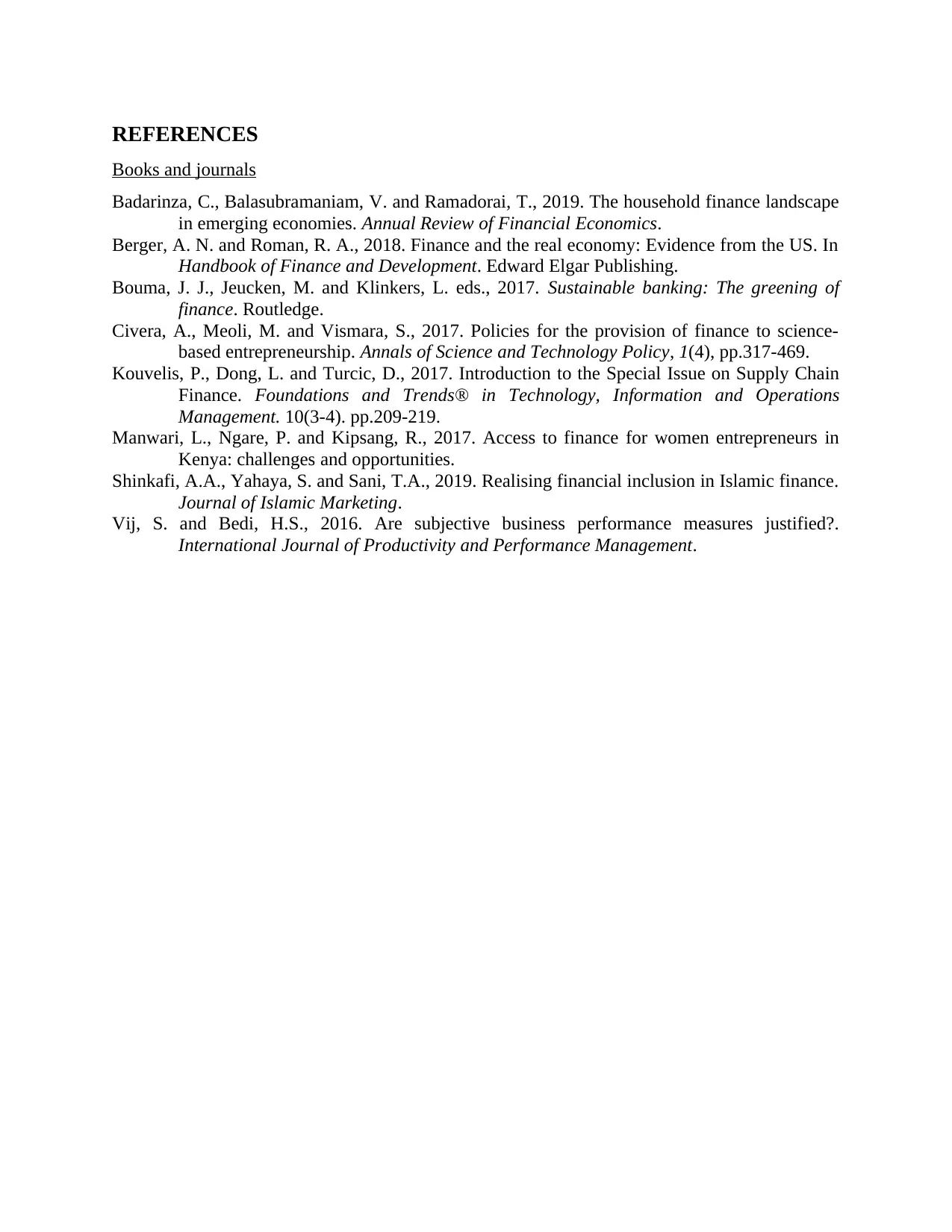
REFERENCES
Books and journals
Badarinza, C., Balasubramaniam, V. and Ramadorai, T., 2019. The household finance landscape
in emerging economies. Annual Review of Financial Economics.
Berger, A. N. and Roman, R. A., 2018. Finance and the real economy: Evidence from the US. In
Handbook of Finance and Development. Edward Elgar Publishing.
Bouma, J. J., Jeucken, M. and Klinkers, L. eds., 2017. Sustainable banking: The greening of
finance. Routledge.
Civera, A., Meoli, M. and Vismara, S., 2017. Policies for the provision of finance to science-
based entrepreneurship. Annals of Science and Technology Policy, 1(4), pp.317-469.
Kouvelis, P., Dong, L. and Turcic, D., 2017. Introduction to the Special Issue on Supply Chain
Finance. Foundations and Trends® in Technology, Information and Operations
Management. 10(3-4). pp.209-219.
Manwari, L., Ngare, P. and Kipsang, R., 2017. Access to finance for women entrepreneurs in
Kenya: challenges and opportunities.
Shinkafi, A.A., Yahaya, S. and Sani, T.A., 2019. Realising financial inclusion in Islamic finance.
Journal of Islamic Marketing.
Vij, S. and Bedi, H.S., 2016. Are subjective business performance measures justified?.
International Journal of Productivity and Performance Management.
Books and journals
Badarinza, C., Balasubramaniam, V. and Ramadorai, T., 2019. The household finance landscape
in emerging economies. Annual Review of Financial Economics.
Berger, A. N. and Roman, R. A., 2018. Finance and the real economy: Evidence from the US. In
Handbook of Finance and Development. Edward Elgar Publishing.
Bouma, J. J., Jeucken, M. and Klinkers, L. eds., 2017. Sustainable banking: The greening of
finance. Routledge.
Civera, A., Meoli, M. and Vismara, S., 2017. Policies for the provision of finance to science-
based entrepreneurship. Annals of Science and Technology Policy, 1(4), pp.317-469.
Kouvelis, P., Dong, L. and Turcic, D., 2017. Introduction to the Special Issue on Supply Chain
Finance. Foundations and Trends® in Technology, Information and Operations
Management. 10(3-4). pp.209-219.
Manwari, L., Ngare, P. and Kipsang, R., 2017. Access to finance for women entrepreneurs in
Kenya: challenges and opportunities.
Shinkafi, A.A., Yahaya, S. and Sani, T.A., 2019. Realising financial inclusion in Islamic finance.
Journal of Islamic Marketing.
Vij, S. and Bedi, H.S., 2016. Are subjective business performance measures justified?.
International Journal of Productivity and Performance Management.
1 out of 10
Related Documents
Your All-in-One AI-Powered Toolkit for Academic Success.
+13062052269
info@desklib.com
Available 24*7 on WhatsApp / Email
![[object Object]](/_next/static/media/star-bottom.7253800d.svg)
Unlock your academic potential
Copyright © 2020–2025 A2Z Services. All Rights Reserved. Developed and managed by ZUCOL.




